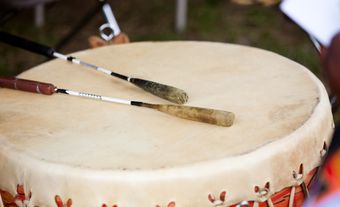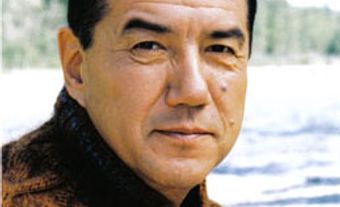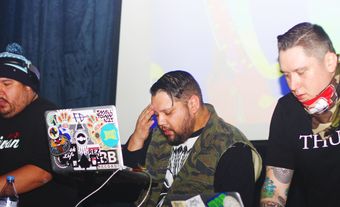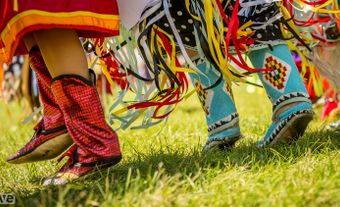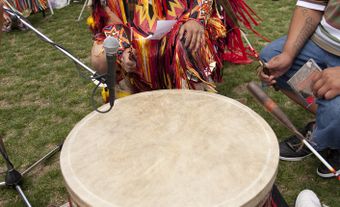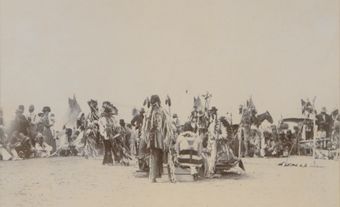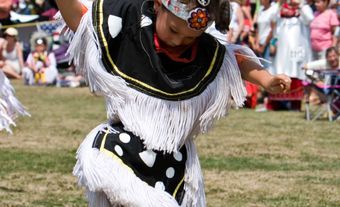Beverly “Buffy” Sainte-Marie (born Beverley Jean Santamaria), CC, singer, songwriter, multi-instrumentalist, educator, social activist, philanthropist, visual artist (born 20 February 1941 in Stoneham, Massachusetts). Buffy Sainte-Marie is a pioneering and influential singer-songwriter. Since the early 1960s, she has identified as Cree from the Piapot First Nation in Saskatchewan. She was an important figure in the Greenwich Village and Toronto folk music revivals in the 1960s, and is perhaps best known for her 1964 anti-war anthem “Universal Soldier.” It was inducted into the Canadian Songwriters Hall of Fame in 2005. Sainte-Marie also won a Golden Globe, a BAFTA and an Academy Award for co-writing the hit song “Up Where We Belong.” She has received the Polaris Music Prize and the Governor General’s Performing Arts Award, as well as multiple Juno Awards, Canadian Aboriginal Music Awards, lifetime achievement awards and honorary degrees. A Companion of the Order of Canada, she has been inducted into the Canadian Music Hall of Fame, the Canadian Country Music Hall of Fame and Canada’s Walk of Fame. Long recognized as a preeminent Indigenous artist, Sainte-Marie’s racial background was called into question by CBC’s The Fifth Estate in October 2023.

Early Life, Family and Birth Claims
Throughout her career, Buffy Sainte-Marie has claimed that she has never known the exact circumstances of her birth. She has said that, after possibly being orphaned or taken from her birth family, she was adopted when she was a few months old. She was then raised in Massachusetts by Albert St. Marie and his wife, Winifred, who Buffy has claimed was part Mi’kmaq.
Sainte-Marie attended the University of Massachusetts, Amherst as an undergrad. She was on track to graduate in 1964 but interrupted her studies to try her luck as a singer-songwriter. She moved to New York City and made a name for herself performing in Greenwich Village and in Toronto. She was soon playing around the world at folk festivals, coffee houses, concert venues and in Indigenous communities.
During this period, in the summer of 1962, Sainte-Marie attended a powwow on Manitoulin Island in Ontario. It was here that she met Emile Piapot of the Piapot First Nation, a Cree community in Saskatchewan’s Qu’Appelle River Valley. Because Emile and his wife, Clara Starblanket, had a daughter who was taken from their reserve around the time Sainte-Marie was born, a friend suggested that perhaps Sainte-Marie could be related to the couple. Sainte-Marie reportedly asked Piapot to give her “an Indian name.” He did so, while also adopting her into his family according to Wahkotowin, Cree law. As Sainte-Marie told the Boston Herald in an article published on 30 October 1963, “You can imagine how honoured I felt they had accepted me. My Cree name is Piyasees Kanikamut, which means ‘Singing Bird.’ I’m a recognized member of the reservation now.” It was also around this time that Sainte-Marie began to claim that she had likely been born on the Piapot First Nation’s reserve. (See also Contested Indigenous Ancestry.)
Recording Career, 1964–76
Buffy Sainte-Marie signed with Vanguard Records, which released It’s My Way! in 1964. The album included “Universal Soldier.” Sainte-Marie has said the song is “about individual responsibility for war and how the old feudal thinking kills us all.” Though not a hit for Sainte-Marie, it was a year later for British singer Donovan. The song was popular as a peace anthem with the anti-Vietnam War movement. It’s My Way! also featured “Cod’ine,” which Sainte-Marie wrote after becoming addicted to codeine while recovering from bronchitis (the song was later covered by Janis Joplin); and “Now That the Buffalo’s Gone,” a protest song about the confiscation of Indigenous peoples’ land. The album earned Sainte-Marie the Best New Artist honour from Billboard magazine in 1964.
Sainte-Marie released 13 more albums through the 1960s and 1970s. Her sound evolved from acoustic folk to incorporate rock, country and electronic music. She also used a wider range of instrumentation to accompany her vibrato voice. Her 1969 release, Illuminations, was the first quadraphonic electronic vocal album ever recorded. It also featured early synthesizers. Many of her early songs were included in The Buffy Sainte-Marie Song Book (Grosset & Dunlap, 1971).
In 1972, Sainte-Marie released Moonshot, the first of four albums she recorded with Nashville-based producer Norbert Putnam (Jimmy Buffet, Joan Baez, John Hiatt). The others were Quiet Places (1973), Buffy (1974) and Changing Woman (1975). Sainte-Marie’s version of Townes Van Zandt’s “Mister Can’t You See,” from Moonshot, was a Top 40 hit in the US in 1972.
After leaving Vanguard Records following her album Quiet Places (1973), Sainte-Marie signed with MCA for two albums: Buffy (1974) and Changing Woman (1975). She then signed with ABC for Sweet America (1976), which she dedicated to the American Indian Movement. (See also Indigenous Political Organization and Activism in Canada; Pan-Indianism.) The song “Starwalker” marked the first time Indigenous and pop music were combined. Sainte-Marie dubbed it “powwow rock.”
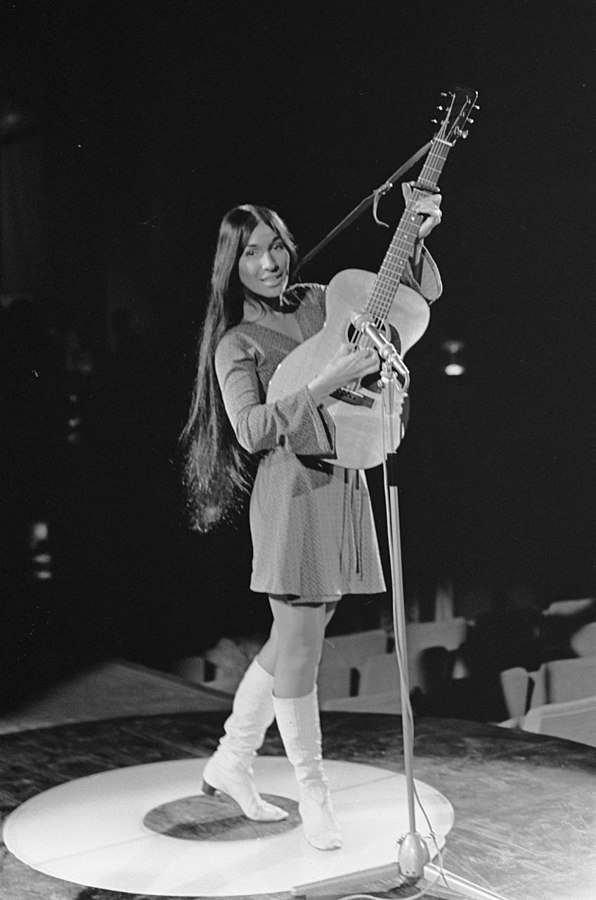
Recording Sabbatical
Following the release of Sweet America in 1976, Sainte-Marie took a 16-year sabbatical from recording to raise her son, Dakota Starblanket Wolfchild. She limited her work to scoring films, performing occasional concerts (such as with the Regina Symphony Orchestra under John Kim Bell), composing, and painting in her home studio in Hawaii, where she has lived for many years. She was a pioneer in her use of Macintosh computers in making music. She has also used them in her digital art. Her paintings have been exhibited in museums and galleries across North America. She also wrote curriculum for her Nihewan Foundation’s main educational initiative, the Cradleboard Teaching Project.
Blacklisting
Buffy Sainte-Marie’s strong stance on Indigenous issues and against the Vietnam War made her unpopular with the Lyndon B. Johnson and Richard Nixon administrations in the United States. As a result, her music was blacklisted from radio stations and held back from reaching a wider audience. Sainte-Marie only discovered this upon seeing her FBI files in the early 1980s. Her many songs about Indigenous peoples and issues include “Starwalker,” “Bury My Heart at Wounded Knee,” “No No Keshagesh,” “Generation,” “Cho Cho Fire,” “Ke Sakihitin Awasis,” “Still This Love Goes On,” “Eagle Man/Changing Woman,” “Native North American Child,” “Now That the Buffalo's Gone,” “Soldier Blue” and “My Country'Tis of Thy People You're Dying.” She rewrote the latter song to reflect specifically Canadian issues. She sang it in Ottawa at the closing day of the Truth and Reconciliation Commission in 2015.
Film and Television Career
Though mostly known for her music, Buffy Sainte-Marie became involved in education and film and television in the late 1960s. When she appeared in a 1968 episode of the NBC TV series The Virginian, she insisted that Indigenous actors be cast in all the Indigenous parts. In 1969, she founded her Nihewan Foundation partly to overcome the stereotyping of Indigenous peoples in public media and education.
Sainte-Marie joined the cast of the popular children’s television show Sesame Street in late-1975. She remained on the program until 1980. She also appeared on several CBC Radio and TV shows, including Superspecial (1978), Pascan: Pow Wow (1982) and The Many Moods of Buffy Sainte-Marie (1983). She also composed the score for the film Spirit of the Wind (1979), the theme song for the CBC TV series Spirit Bay (1984–86), and several other film scores in the US.
Sainte-Marie enjoyed huge commercial success with the song “Up Where We Belong,” which she co-wrote with Will Jennings and her then-husband, film composer Jack Nitzsche. The writing team for the song, which was featured in the hit film An Officer and a Gentleman (1982), won an Academy Award, a BAFTA and a Golden Globe for Best Original Song. The song was a platinum-certified No. 1 hit in the US. It was later recorded as a duet by Cliff Richard and Anne Murray, as well as by Céline Dion.
Sainte-Marie also wrote and performed the music for the film Where the Spirit Lives (1989). It deals with Indigenous children being abducted and forced into residential schools. She voiced the Cheyenne character, Kate Bighead, in the TV movie Son of the Morning Star (1991), which tells the Indigenous side of the Battle of the Little Bighorn, and appeared with Graham Greene in the 1993 TV Movie The Broken Chain. Her 1996 variety special, Up Where We Belong, won her a Gemini Award.
Educator and Philanthropist
Buffy Sainte-Marie has dedicated much of her life to education. After graduating with honours in Oriental philosophy and education from the University of Massachusetts, Amherst in 1970, she obtained an honorary doctorate in fine arts from the same school in 1983. She has taught music and digital art at the Saskatchewan Federated Indian College, York University, Evergreen State College in Washington and the Institute for American Indian Arts in New Mexico.
She founded the philanthropic non-profit fund Nihewan Foundation for Native American Education in 1969. In 1996, she created the Cradleboard Teaching Project. It facilitates communication among Indigenous and mainstream school children through computer networking. Sainte-Marie used her multimedia skills to create a core curriculum based in Indigenous cultural perspectives. She also produced, directed and appeared in Cradleboard’s interactive multimedia CD-ROM, Science: Through Native American Eyes. She has been a spokesperson for the United Nations Educational, Scientific and Cultural Organization (UNESCO) and gives speaking engagements and presentations about her career and philanthropic projects.
Recording Career, 1992–2014
Buffy Sainte-Marie resumed her recording career in 1992 with the release of Coincidence and Likely Stories. It was the first album to be delivered digitally via the fledgling Internet. Recorded at her home in Hawaii, she sent it via dialup modem to the London studio of producer Chris Birkett (Sinéad O'Connor, Steve Earle, The Proclaimers), with whom she would make four more albums. Coincidence and Likely Stories features both electronic backings and traditional Indigenous chants. It won Sainte-Marie a Charles de Gaulle Award in France for Best International Artist.
She followed that pioneering effort with Up Where We Belong (1996), a collection of new and previously recorded songs that combines elements of pop, protest and powwow music. It received the Juno Award for Best Music of Aboriginal Canada Recording in 1997. Sainte-Marie’s lobbying had been instrumental in the creation of that award, which was first presented in 1994.
Between 1997 and 2009, Sainte-Marie dedicated her time and money to the Cradleboard Teaching Project. She travelled extensively and did not record, though she did perform during this time in Sweden, Denmark and France. She also appeared at the Ottawa Folk Festival in 2002. In 2005, her signature song, “Universal Soldier,” was inducted into the Canadian Songwriters Hall of Fame.
Following Vanguard's release of the compilation album The Best of the Vanguard Years (2003), Sainte-Marie independently released Running for the Drum (2008), a collection of 12 new songs. It featured American blues musician Taj Mahal on piano and won the 2009 Juno Award for Aboriginal Recording of the Year, as well as four Canadian Aboriginal Music Awards. Buffy Sainte-Marie: A Multimedia Life (2006), an hour-long documentary featuring archival footage and interviews with several well-known musicians, was also nominated for a 2009 Juno Award for Music DVD of the Year.
In 2012, Blair Stonechild’s award-winning biography, Buffy Sainte-Marie: It’s My Way, was published by Fifth House.
Recording Career, 2015–Present
Buffy Sainte-Marie continued to record and tour well into her seventies. Her album Power in the Blood (2015), recorded on her Gypsy Boy label and distributed by True North Records, won the 2015 Polaris Music Prize as well as 2016 Juno Awards for Aboriginal Album and Contemporary Roots Album of the Year. Sainte-Marie was also featured on the single re-mix of her song “Working for the Government” by fellow Polaris nominee A Tribe Called Red (now The Halluci Nation). In 2015, she received the Spirit of Americana/Free Speech in Music Award from the Americana Music Association. At the 2017 Juno Awards, she received the Allan Waters Humanitarian Award.
Sainte-Marie’s 19th album, Medicine Songs (2017), features a mix of new material, such as “You Got to Run (Spirit of the Wind),” a collaboration with Tanya Tagaq, and re-recorded older songs, including “Starwalker,” “Little Wheel Spin and Spin” and “Bury My Heart at Wounded Knee.” The album drew positive reviews, with NOW magazine’s Michael Rancic observing, “Another artist might show signs of disappointment or uncertainty when faced with the notion that not much has changed in half a century, but on Medicine Songs, in the face of the unchanging nature of the oppression she’s expressed through her music, Buffy Sainte-Marie has chosen to be just as determined, unflinching and constant in her own art.” Medicine Songs went on to win the 2018 Juno Award for Indigenous Music Album of the Year.
On 22 September 2022, the National Arts Centre (NAC) in Ottawa hosted Starwalker: A Celebration of the Songs, Music and Life of Buffy Sainte-Marie. It featured performances by Jeremy Dutcher, Leela Gilday, The Halluci Nation, and William Prince, among others. The concert was the culmination of Buffy Sainte-Marie: Pathfinder, a retrospective of Sainte-Marie’s digital artwork, personal sketches and artifacts. It was on display at the NAC from 27 August to 18 September 2022.
In August 2023, the 82-year-old Sainte-Marie announced that she would no longer be performing live. She cited health concerns and physical limitations, such as arthritis and a shoulder injury, making it “no longer possible to perform to my standards.”
Contested Indigenous Ancestry
An investigation conducted by CBC’s The Fifth Estate and broadcast on 27 October 2023 cast doubt on the veracity of Buffy Sainte-Marie’s claims to Indigenous ancestry. The Fifth Estate managed to locate Sainte-Marie’s birth certificate — which she has said for years did not exist — at the town hall in Stoneham, Massachusetts. It lists Beverly Jean Santamaria as being born to Albert and Winifred Santamaria in Stoneham on 20 February 1941. Under “Color or race,” Albert, Winifred and Beverly are all listed as “white.” (Albert was of Italian descent while Winifred’s ancestry was primarily English.) Furthermore, the birth certificate is listed as No. 49 in a chronological sequence of registered births, ruling out the possibility that it was issued to Albert and Winifred after the fact, as was sometimes the case with adopted children. Had Buffy been adopted from Canada, the file would also include her legal adoption records and proof of her entry to the United States, none of which were present.
The Fifth Estate also backed up the information on the birth certificate with several corroborating documents. These include the 1950 US census, which lists nine-year-old Beverly as a white girl, born in Massachusetts, and even Buffy’s own 1982 marriage certificate to Jack Nitzsche, which says that she was born in Massachusetts to Albert and Winifred St. Marie on 20 February 1941. (Some members of the Santamaria family, including Buffy’s parents, started going by St. Marie during the Second World War, due to rampant anti-Italian sentiments.) The program pointed out that Sainte-Marie had either claimed to be or was described as Algonquin, Mi’kmaq or half-Mi’kmaq before she first identified as Cree in 1963. It also included multiple examples of members of the Santamaria family going public with this knowledge as early as 1964.
On the eve of the broadcast of the Fifth Estate episode, the Piapot family in Saskatchewan — relatives of Emile Piapot, who had adopted Sainte-Marie according to Wahkotowin, Cree law, in 1962 — issued a statement calling the accusations against Sainte-Marie “hurtful, ignorant, colonial — and racist.” It also stated: “Buffy is our family. We chose her and she chose us. We claim her as a member of our family and all of our family members are from the Piapot First Nation. To us, that holds far more weight than any paper documentation or colonial record keeping ever could.” Many observers have pointed out that most Cree people consider Wahkotowin more valid than colonial paperwork because it is Indigenous law, not colonial law, although it still does not confer legal or official status beyond that nation. (See also Indian Status.)
In her own statement released to the media, Sainte-Marie claimed that “my growing up mother… told me many things, including that I was adopted and that I was Native…. Later in my life, as an adult, she told me some things that I have never shared out of respect for her that I hate sharing now, including that I may have been born on ‘the wrong side of the blanket’ [meaning to a father who was not her mother’s husband]…. I have always struggled to answer questions about who I am…. All I can say is what I know to be true: I know who I love, I know who loves me. And I know who claims me. I may not know where I was born, but I know who I am.”
(See also Music of Indigenous Peoples in Canada.)
Honours and Awards
Juno Awards
- Inductee, Canadian Music Hall of Fame (1995)
- Best Music of Aboriginal Canada Recording (Up Where We Belong) (1997)
- Aboriginal Recording of the Year (Running for the Drum) (2009)
- Aboriginal Album of the Year (Power in the Blood) (2016)
- Contemporary Roots Album of the Year (Power in the Blood) (2016)
- Allan Waters Humanitarian Award (2017)
- Indigenous Music Album of the Year (Medicine Songs) (2018)
Canadian Aboriginal Music Awards
- Lifetime Achievement Award (2008)
- Best Album of the Year (Running for the Drum) (2009)
- Best Female Artist (2009)
- Best Song Single (“No No Keshagesh”) (2009)
- Best Songwriter (2009)
Aboriginal Peoples Choice Music Awards
- Best Folk/Acoustic CD (Running for the Drum) (2009)
- Best Music Video (“No No Keshagesh”) (2010)
Others
- Best New Artist, Billboard magazine (1964)
- Best Original Song, Academy Awards (1983)
- Best Original Song, Golden Globe Awards (1983)
- Best Original Song, British Academy of Film & Television Arts (BAFTA) Award (1984)
- Best International Artist, Charles de Gaulle Award (1993)
- Lifetime Achievement Award, Saskatchewan Recording Industry Association (1994)
- Native American Philanthropist of the Year (1997)
- Best Performance in a Variety Program or Series (Buffy Sainte-Marie: Up Where We Belong), Gemini Awards (1997)
- Officer, Order of Canada (1997)
- Contemporary Gospel Recorded Song of the Year, Dove Awards (1998)
- Lifetime Achievement Award, American Indian College Fund (1998)
- Lifetime Achievement Award, National Aboriginal Achievement Foundation (1998)
- Inductee, Canada’s Walk of Fame (1999)
- Queen Elizabeth II Golden Jubilee Medal, Government of Canada (2002)
- Inductee (“Universal Soldier”), Canadian Songwriters Hall of Fame (2005)
- Inductee, Canadian Country Music Hall of Fame (2009)
- Governor General’s Performing Arts Award, Government of Canada (2010)
- Queen Elizabeth II Diamond Jubilee Medal, Government of Canada (2012)
- Spirit of Americana/Free Speech in Music Award, Americana Music Association (2015)
- Polaris Music Prize (Power in the Blood) (2015)
- Canadian Songwriters Hall of Fame (2019)
- Companion, Order of Canada (2019)
- Allan Slaight Humanitarian Spirit Award, Canadian Music and Broadcast Industry Awards (2020)
- Featured in a commemorative stamp issued by Canada Post (2021)
Honorary Degrees
- Doctor of Fine Arts, University of Massachusetts (1983)
- Doctor of Laws, University of Regina (1996)
- Doctor of Letters, Lakehead University (2000)
- Doctor of Humanities, University of Saskatchewan (2003)
- Doctor of Letters, Emily Carr University of Art and Design (2007)
- Doctor of Laws, Carleton University (2008)
- Doctor of Music, University of Western Ontario (2009)
- Doctor of Letters, Wilfrid Laurier University (2010)
- Doctor of Fine Arts, Ontario College of Art and Design (2010)
- Doctor of Letters, University of British Columbia (2012)
- Doctor of Laws, Vancouver Island University (2016)
- Doctor of Laws, University of Lethbridge (2017)
- Doctor of Laws, Dalhousie University (2018)
- Doctor of Laws, University of Toronto (2019)

 Share on Facebook
Share on Facebook Share on X
Share on X Share by Email
Share by Email Share on Google Classroom
Share on Google Classroom
